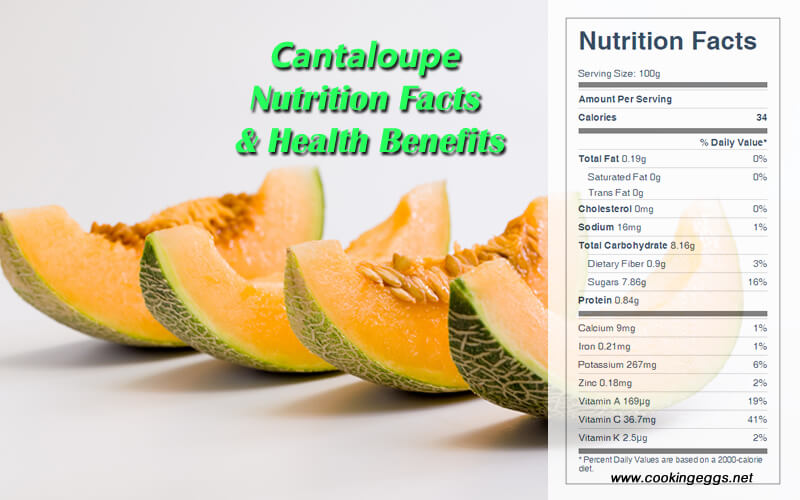Cantaloupe Nutrition Facts & Health Benefits
Cantaloupe refers to any orange-fleshed melons of the muskmelon species. Cantaloupe is low in calories and is one of the easiest foods to digest.
The nutritional composition of cantaloupe
Raw cantaloupe is 90% water, 8% carbohydrates, 0.8% protein, and 0.2% fat, providing 34 kcal and 2020 g of the provitamin A orange carotenoid, beta-carotene per 100 grams. Fresh cantaloupe is a rich source of vitamin C and vitamin A.
One cup of raw cantaloupe provides 56 calories, 13.4 g carbohydrate, 1.4 g protein, 0.4 g fat, 1.3 g dietary fiber, 5158 IU vitamin A, 68 mg vitamin C, 27 mcg folic acid, 494 mg potassium, 18 mg calcium, 27 mg phosphorus, and 18 mg magnesium.

Cantaloupe Nutrition Facts Label
Health Benefits of Cantaloupe
Cantaloupe is rich in fiber, pectin, beta-carotene, vitamins B6 and C, flavonoids, potassium, carbohydrates, and protein. The part of the melon close to the rind is rich in silicon. Cantaloupe also contains adenosine, a compound used in modern medicine as a blood-thinning agent.
What gives cantaloupe a special place among the SuperFoods is its high betacarotene content, indicated by its rich orange color. It’s also a good source of vitamin A. Cantaloupe cubes have only 56 calories per cup but contain 103.2 percent of the daily value for vitamin A. Since beta-carotene can be converted into vitamin A in the body, when you eat cantaloupe, it’s like getting a double helping! Vitamin A appears to reduce the risk of cataracts, and it’s a good source of lutein, which some studies have suggested may have a role in preventing age-related macular degeneration, a major cause of blindness in the elderly.
Given their orange color, we know cantaloupes possess a great amount of vitamin C, vitamin A, and vitamin E, which contribute to their antioxidant and nutrient-dense properties. Cantaloupes have potent analgesic and anti-inflammatory activity, anti-ulcer properties, and the ability to strengthen the gut wall. Gallic acid, ellagic acid, and kaempferol all have demonstrated antiviral, anticancer, and antioxidant effects in various studies. Ferulic acid has a wide variety of benefits, including antioxidant, anti-inflammatory, antimicrobial, antiallergic, liver protective, antiviral, and anticancer.
Pharmacological studies on melons indicate potential in the treatment of pain, inflammation, liver disease, cancer, cough, and the list goes on. Triterpenoids and sterols are bioactive compounds that contribute to its unique ability to have a direct benefit in leaky gut!And the peel and seeds have an abundance of phytochemical properties.
Cantaloupes have a unique ability to increase neutrophils (immune cells), which constitutes a proinflammatory ability as they remove toxic reactive oxygen species. This antioxidant ability is due to the high presence of phenolic compounds, especially flavonoids.
The benefits of cantaloupes aren’t just in the tasty fruit, but in the peel and seeds as well! The peel and seeds contain significant bioactive content such as gallic acid, caffeic acid, syringic acid, ferulic acid, ellagic acid, quercetin, and kaempferol. Studies on cantaloupe fruit peel extracts showed a significant increase in both thyroid hormones (T3 and T4) and a decrease in tissue damage. While we probably wouldn’t directly eat the peel, it is increasingly being developed as a supplemental functional food.
Note: Because the surface of a cantaloupe can contain harmful bacteria—in particular, Salmonella—it is recommended that a melon be washed and scrubbed thoroughly before cutting and consumption. The fruit should be refrigerated after cutting it and consumed in less than three days to prevent the risk of Salmonella or other bacterial pathogens.